Problems of Waste Management in Australian Construction Projects
VerifiedAdded on 2022/10/17
|27
|5922
|23
Report
AI Summary
This report delves into the critical issues of waste management within the Australian construction industry. It begins by highlighting the increasing generation of construction waste due to urbanization and population growth, emphasizing the environmental impact of non-renewable resources and pollutants, including air and water pollution. The report explores the decline of landfill spaces and the lack of effective waste management practices, leading to increased costs and environmental concerns. It examines the importance of waste management from the design phase through procurement, onsite management, and the application of industrial ecology principles, including material reuse, waste prediction tools, and site waste management planning. The research questions focus on the specific problems faced, current waste management practices, and potential mitigation strategies. The report also discusses the significance of the study, emphasizing the need for employee training on sustainable waste management and the importance of efficient waste management in the construction industry. It reviews literature on construction waste management, including the challenges and the methodologies to manage construction waste, such as source reduction, material reuse, and offsite construction.
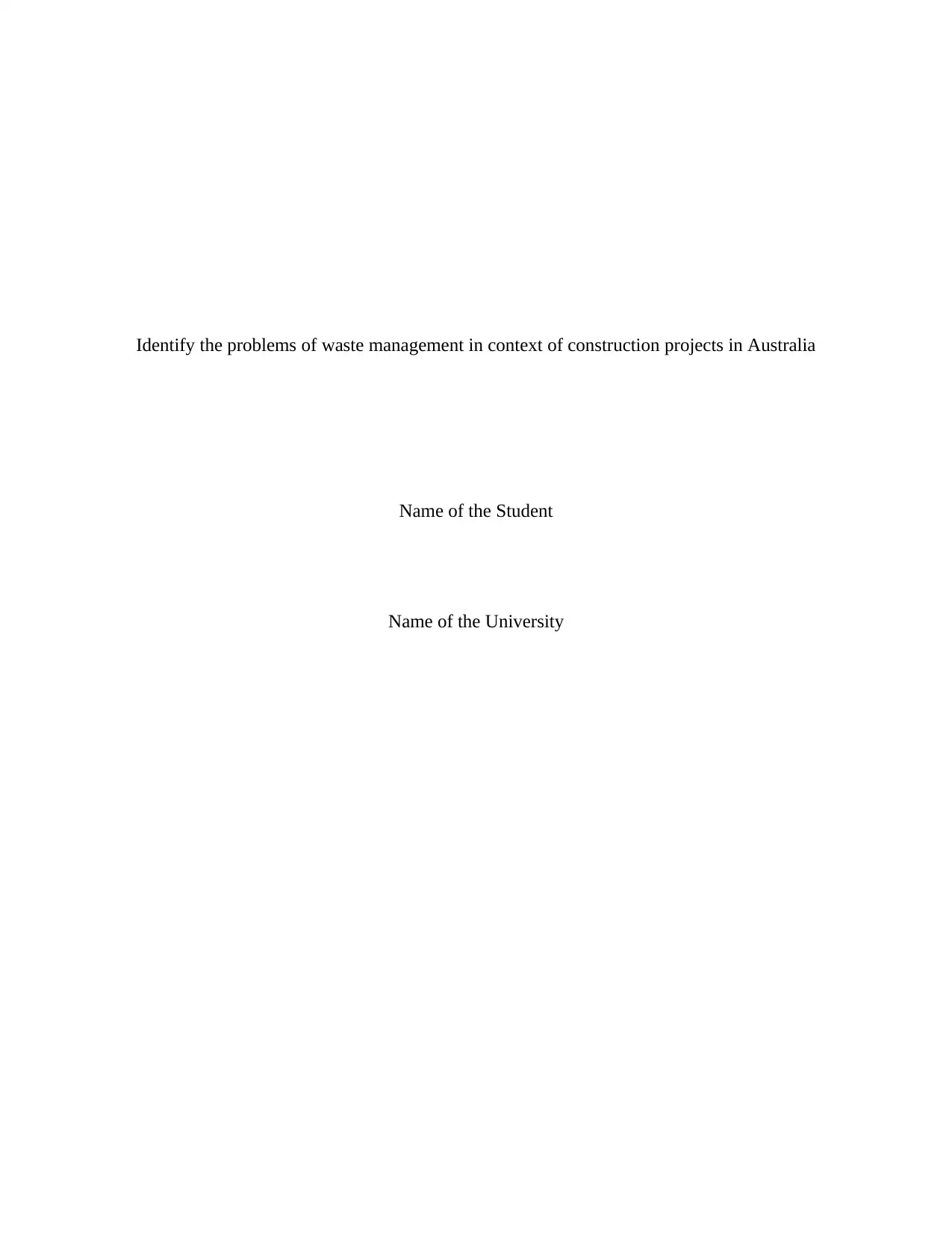
Identify the problems of waste management in context of construction projects in Australia
Name of the Student
Name of the University
Name of the Student
Name of the University
Paraphrase This Document
Need a fresh take? Get an instant paraphrase of this document with our AI Paraphraser
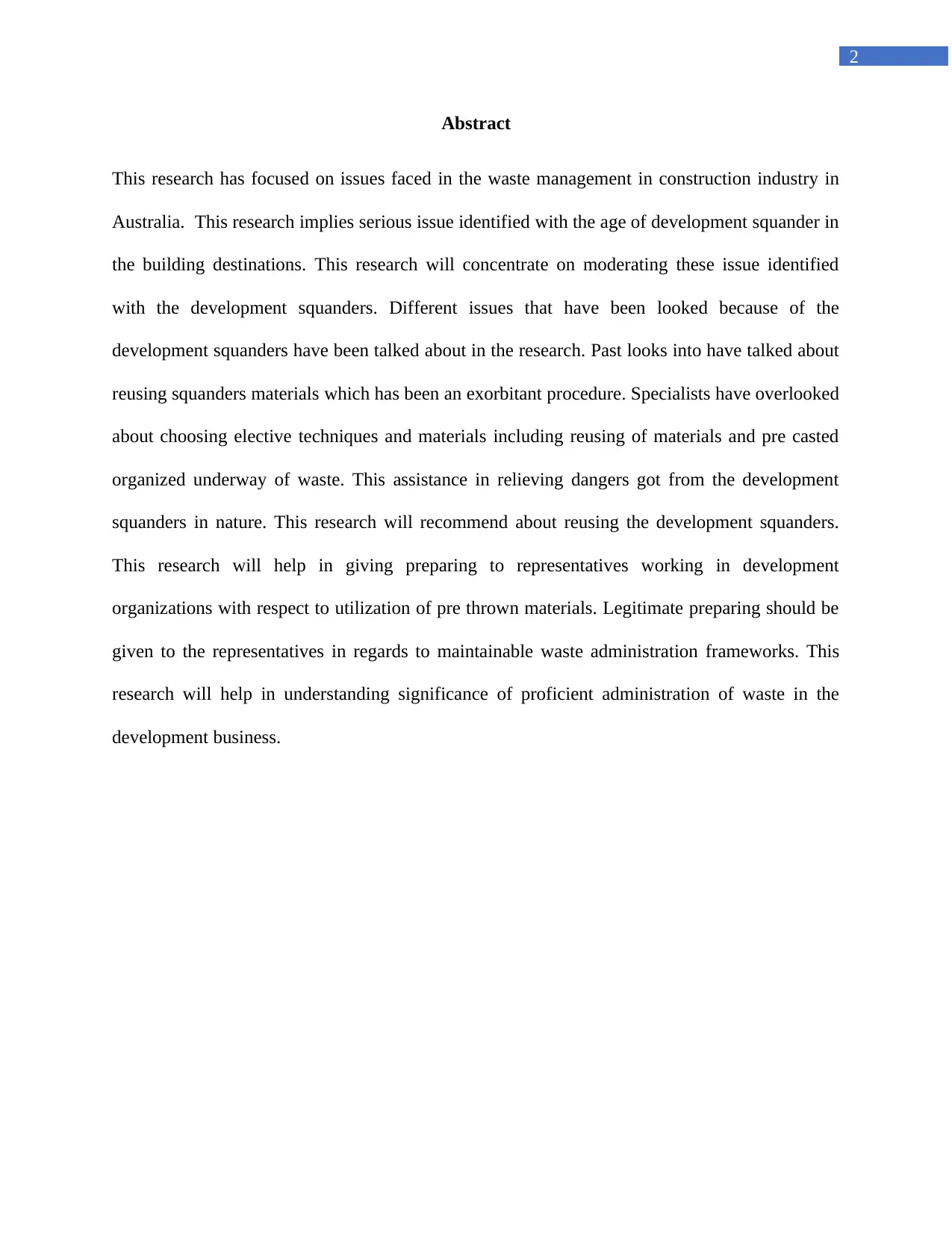
2
Abstract
This research has focused on issues faced in the waste management in construction industry in
Australia. This research implies serious issue identified with the age of development squander in
the building destinations. This research will concentrate on moderating these issue identified
with the development squanders. Different issues that have been looked because of the
development squanders have been talked about in the research. Past looks into have talked about
reusing squanders materials which has been an exorbitant procedure. Specialists have overlooked
about choosing elective techniques and materials including reusing of materials and pre casted
organized underway of waste. This assistance in relieving dangers got from the development
squanders in nature. This research will recommend about reusing the development squanders.
This research will help in giving preparing to representatives working in development
organizations with respect to utilization of pre thrown materials. Legitimate preparing should be
given to the representatives in regards to maintainable waste administration frameworks. This
research will help in understanding significance of proficient administration of waste in the
development business.
Abstract
This research has focused on issues faced in the waste management in construction industry in
Australia. This research implies serious issue identified with the age of development squander in
the building destinations. This research will concentrate on moderating these issue identified
with the development squanders. Different issues that have been looked because of the
development squanders have been talked about in the research. Past looks into have talked about
reusing squanders materials which has been an exorbitant procedure. Specialists have overlooked
about choosing elective techniques and materials including reusing of materials and pre casted
organized underway of waste. This assistance in relieving dangers got from the development
squanders in nature. This research will recommend about reusing the development squanders.
This research will help in giving preparing to representatives working in development
organizations with respect to utilization of pre thrown materials. Legitimate preparing should be
given to the representatives in regards to maintainable waste administration frameworks. This
research will help in understanding significance of proficient administration of waste in the
development business.

3
Table of Contents
1. Rationale of the study..................................................................................................................4
2. Significance of the study.............................................................................................................6
3. Literature Review........................................................................................................................7
3.1 Construction waste management...........................................................................................7
3.2 Management of Construction waste in construction industry...............................................8
4. Research questions and Objectives............................................................................................10
5. Research Methodology..............................................................................................................11
5.1 Research Approach..............................................................................................................11
5.2 Data Collection methods and analysis.................................................................................11
5.3 Ethics Statement..................................................................................................................15
6. Research Project Management..................................................................................................16
Project Exclusions.....................................................................................................................16
Risk Register..............................................................................................................................16
Stakeholder Analysis.................................................................................................................18
References......................................................................................................................................20
Appendices....................................................................................................................................24
Table of Contents
1. Rationale of the study..................................................................................................................4
2. Significance of the study.............................................................................................................6
3. Literature Review........................................................................................................................7
3.1 Construction waste management...........................................................................................7
3.2 Management of Construction waste in construction industry...............................................8
4. Research questions and Objectives............................................................................................10
5. Research Methodology..............................................................................................................11
5.1 Research Approach..............................................................................................................11
5.2 Data Collection methods and analysis.................................................................................11
5.3 Ethics Statement..................................................................................................................15
6. Research Project Management..................................................................................................16
Project Exclusions.....................................................................................................................16
Risk Register..............................................................................................................................16
Stakeholder Analysis.................................................................................................................18
References......................................................................................................................................20
Appendices....................................................................................................................................24
⊘ This is a preview!⊘
Do you want full access?
Subscribe today to unlock all pages.

Trusted by 1+ million students worldwide

4
1. Rationale of the study
Rapid increase in population and urbanization has resulted in growth in construction
activities in Australia. This has increased in large amount of construction wastages in the
construction sites. According to recent survey in 2018, 60% of the world’s population lives in
urban areas and this might increase to 68% by 2050 (Yuan 2013). Therefore, there has been
increase in pressure over construction industries in the market. Construction of buildings and
complexes are going in to maintain requirements of people. This has led to increase in generation
of construction waste in the environment. Construction wastes are majorly non-renewable
resources and pollutants in the environment. These pollutants are creating pollution in the
environment including air and water pollution (Yeheyis et al. 2013). Construction activities
generate more amount of wastes compared with other industries. Therefore, this has been a
critical point for the countries having ongoing construction projects. Australia has faced growing
utilize of organic polymers and chemical activities in construction sites wastes increasing by
hazardous substances. There has been sharp decline in landfill space and opposition form public
for creation of new landfill spaces (Yuan 2012). This has caused increase in costs of
construction. This cist will pass to the clients and lastly to society. The major problem faced by
Australian construction industry is the decline of landfill spaces and lack of proper construction
waste management.
The natural advantages of waste administration incorporate drawing out the life of landfill
destinations and diminishing primary asset necessities (CIRIA 1993). What's more, waste
management would serve to diminish transport needs and their related effect on nature (CIRIA,
1993) (Lu and Tam 2013). Social advantages incorporate the evasion of making new and
unfortunate landfill locales, stemming potential natural wellbeing risks related with waste and its
1. Rationale of the study
Rapid increase in population and urbanization has resulted in growth in construction
activities in Australia. This has increased in large amount of construction wastages in the
construction sites. According to recent survey in 2018, 60% of the world’s population lives in
urban areas and this might increase to 68% by 2050 (Yuan 2013). Therefore, there has been
increase in pressure over construction industries in the market. Construction of buildings and
complexes are going in to maintain requirements of people. This has led to increase in generation
of construction waste in the environment. Construction wastes are majorly non-renewable
resources and pollutants in the environment. These pollutants are creating pollution in the
environment including air and water pollution (Yeheyis et al. 2013). Construction activities
generate more amount of wastes compared with other industries. Therefore, this has been a
critical point for the countries having ongoing construction projects. Australia has faced growing
utilize of organic polymers and chemical activities in construction sites wastes increasing by
hazardous substances. There has been sharp decline in landfill space and opposition form public
for creation of new landfill spaces (Yuan 2012). This has caused increase in costs of
construction. This cist will pass to the clients and lastly to society. The major problem faced by
Australian construction industry is the decline of landfill spaces and lack of proper construction
waste management.
The natural advantages of waste administration incorporate drawing out the life of landfill
destinations and diminishing primary asset necessities (CIRIA 1993). What's more, waste
management would serve to diminish transport needs and their related effect on nature (CIRIA,
1993) (Lu and Tam 2013). Social advantages incorporate the evasion of making new and
unfortunate landfill locales, stemming potential natural wellbeing risks related with waste and its
Paraphrase This Document
Need a fresh take? Get an instant paraphrase of this document with our AI Paraphraser
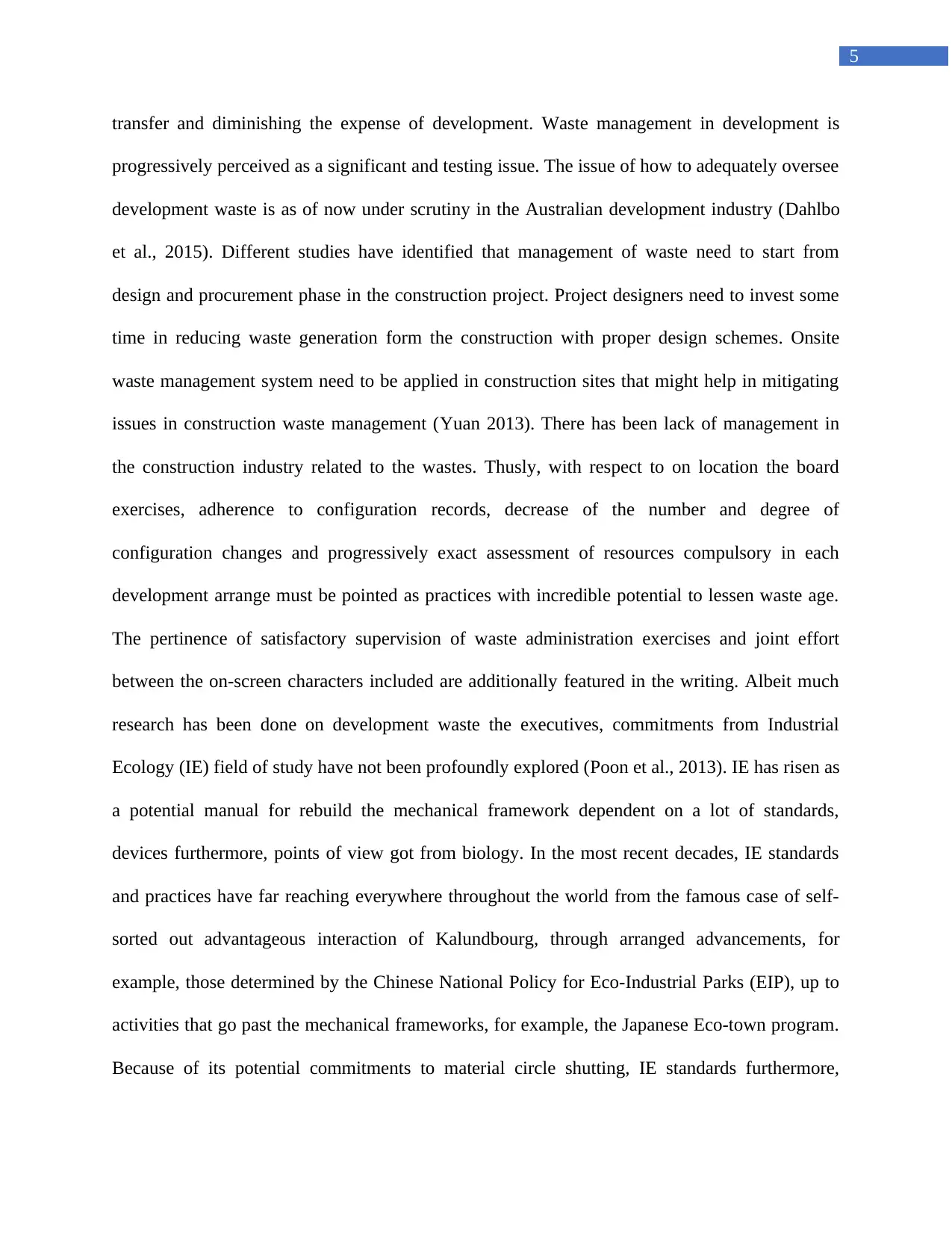
5
transfer and diminishing the expense of development. Waste management in development is
progressively perceived as a significant and testing issue. The issue of how to adequately oversee
development waste is as of now under scrutiny in the Australian development industry (Dahlbo
et al., 2015). Different studies have identified that management of waste need to start from
design and procurement phase in the construction project. Project designers need to invest some
time in reducing waste generation form the construction with proper design schemes. Onsite
waste management system need to be applied in construction sites that might help in mitigating
issues in construction waste management (Yuan 2013). There has been lack of management in
the construction industry related to the wastes. Thusly, with respect to on location the board
exercises, adherence to configuration records, decrease of the number and degree of
configuration changes and progressively exact assessment of resources compulsory in each
development arrange must be pointed as practices with incredible potential to lessen waste age.
The pertinence of satisfactory supervision of waste administration exercises and joint effort
between the on-screen characters included are additionally featured in the writing. Albeit much
research has been done on development waste the executives, commitments from Industrial
Ecology (IE) field of study have not been profoundly explored (Poon et al., 2013). IE has risen as
a potential manual for rebuild the mechanical framework dependent on a lot of standards,
devices furthermore, points of view got from biology. In the most recent decades, IE standards
and practices have far reaching everywhere throughout the world from the famous case of self-
sorted out advantageous interaction of Kalundbourg, through arranged advancements, for
example, those determined by the Chinese National Policy for Eco-Industrial Parks (EIP), up to
activities that go past the mechanical frameworks, for example, the Japanese Eco-town program.
Because of its potential commitments to material circle shutting, IE standards furthermore,
transfer and diminishing the expense of development. Waste management in development is
progressively perceived as a significant and testing issue. The issue of how to adequately oversee
development waste is as of now under scrutiny in the Australian development industry (Dahlbo
et al., 2015). Different studies have identified that management of waste need to start from
design and procurement phase in the construction project. Project designers need to invest some
time in reducing waste generation form the construction with proper design schemes. Onsite
waste management system need to be applied in construction sites that might help in mitigating
issues in construction waste management (Yuan 2013). There has been lack of management in
the construction industry related to the wastes. Thusly, with respect to on location the board
exercises, adherence to configuration records, decrease of the number and degree of
configuration changes and progressively exact assessment of resources compulsory in each
development arrange must be pointed as practices with incredible potential to lessen waste age.
The pertinence of satisfactory supervision of waste administration exercises and joint effort
between the on-screen characters included are additionally featured in the writing. Albeit much
research has been done on development waste the executives, commitments from Industrial
Ecology (IE) field of study have not been profoundly explored (Poon et al., 2013). IE has risen as
a potential manual for rebuild the mechanical framework dependent on a lot of standards,
devices furthermore, points of view got from biology. In the most recent decades, IE standards
and practices have far reaching everywhere throughout the world from the famous case of self-
sorted out advantageous interaction of Kalundbourg, through arranged advancements, for
example, those determined by the Chinese National Policy for Eco-Industrial Parks (EIP), up to
activities that go past the mechanical frameworks, for example, the Japanese Eco-town program.
Because of its potential commitments to material circle shutting, IE standards furthermore,
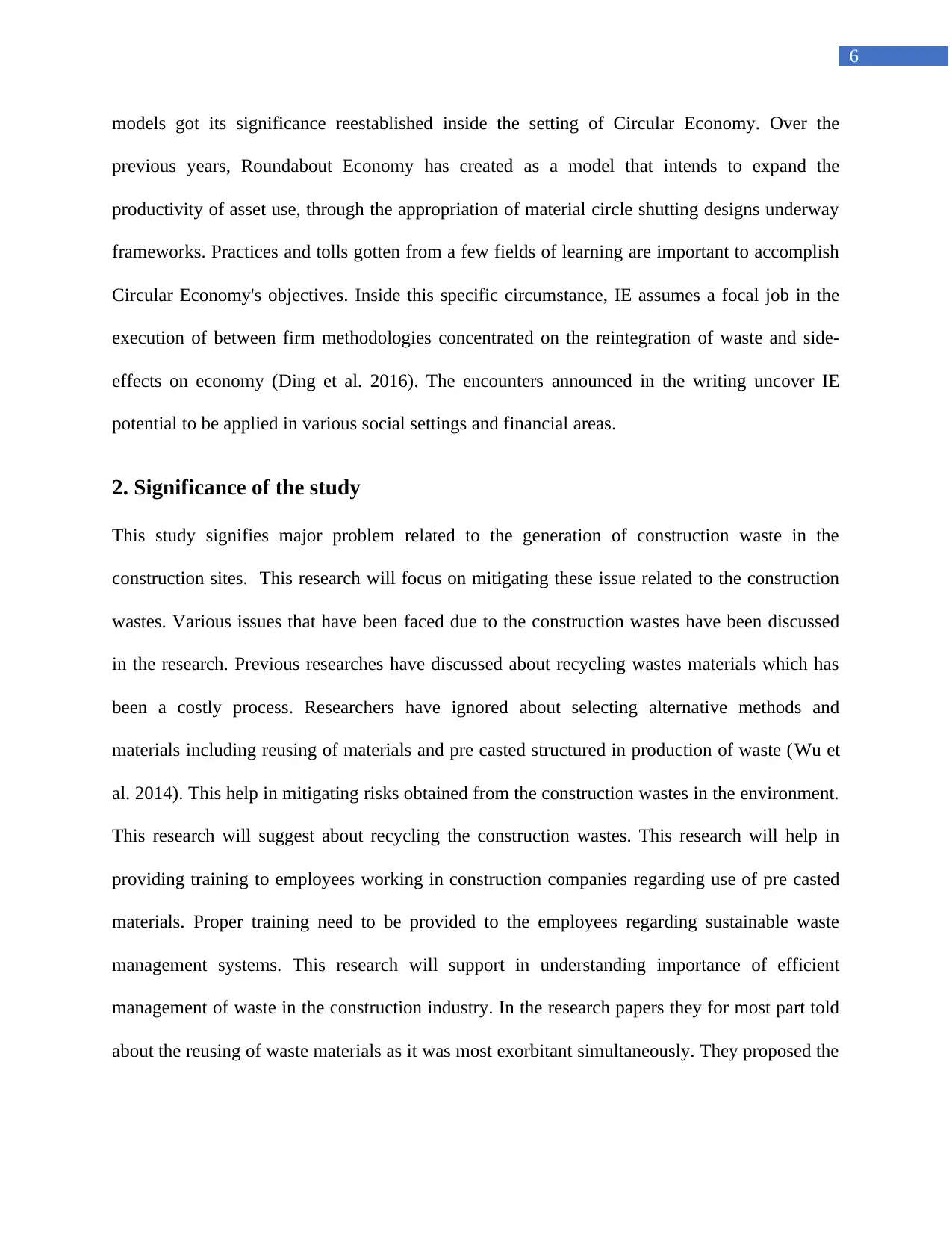
6
models got its significance reestablished inside the setting of Circular Economy. Over the
previous years, Roundabout Economy has created as a model that intends to expand the
productivity of asset use, through the appropriation of material circle shutting designs underway
frameworks. Practices and tolls gotten from a few fields of learning are important to accomplish
Circular Economy's objectives. Inside this specific circumstance, IE assumes a focal job in the
execution of between firm methodologies concentrated on the reintegration of waste and side-
effects on economy (Ding et al. 2016). The encounters announced in the writing uncover IE
potential to be applied in various social settings and financial areas.
2. Significance of the study
This study signifies major problem related to the generation of construction waste in the
construction sites. This research will focus on mitigating these issue related to the construction
wastes. Various issues that have been faced due to the construction wastes have been discussed
in the research. Previous researches have discussed about recycling wastes materials which has
been a costly process. Researchers have ignored about selecting alternative methods and
materials including reusing of materials and pre casted structured in production of waste (Wu et
al. 2014). This help in mitigating risks obtained from the construction wastes in the environment.
This research will suggest about recycling the construction wastes. This research will help in
providing training to employees working in construction companies regarding use of pre casted
materials. Proper training need to be provided to the employees regarding sustainable waste
management systems. This research will support in understanding importance of efficient
management of waste in the construction industry. In the research papers they for most part told
about the reusing of waste materials as it was most exorbitant simultaneously. They proposed the
models got its significance reestablished inside the setting of Circular Economy. Over the
previous years, Roundabout Economy has created as a model that intends to expand the
productivity of asset use, through the appropriation of material circle shutting designs underway
frameworks. Practices and tolls gotten from a few fields of learning are important to accomplish
Circular Economy's objectives. Inside this specific circumstance, IE assumes a focal job in the
execution of between firm methodologies concentrated on the reintegration of waste and side-
effects on economy (Ding et al. 2016). The encounters announced in the writing uncover IE
potential to be applied in various social settings and financial areas.
2. Significance of the study
This study signifies major problem related to the generation of construction waste in the
construction sites. This research will focus on mitigating these issue related to the construction
wastes. Various issues that have been faced due to the construction wastes have been discussed
in the research. Previous researches have discussed about recycling wastes materials which has
been a costly process. Researchers have ignored about selecting alternative methods and
materials including reusing of materials and pre casted structured in production of waste (Wu et
al. 2014). This help in mitigating risks obtained from the construction wastes in the environment.
This research will suggest about recycling the construction wastes. This research will help in
providing training to employees working in construction companies regarding use of pre casted
materials. Proper training need to be provided to the employees regarding sustainable waste
management systems. This research will support in understanding importance of efficient
management of waste in the construction industry. In the research papers they for most part told
about the reusing of waste materials as it was most exorbitant simultaneously. They proposed the
⊘ This is a preview!⊘
Do you want full access?
Subscribe today to unlock all pages.

Trusted by 1+ million students worldwide

7
significance of the waste administration lastly they told about the reusing, yet they don't
recommend about the proficient strategy.
3. Literature Review
3.1 Construction waste management
Waste management has been a broad concept that focuses on process depending in waste
materials as the result of activities of humans. The scale of the waste generation depend on
industry on which waste is generated. As commented by Yean Yng Ling and Song Anh Nguyen
(2013), construction industry used to generate maximum number of waste material as compared
to other industries. Construction waste management (CWM) focuses on eliminating waste
materials coming out from construction sites. The importance of construction waste management
has been depended in managing waste materials and disposing them to landfills as per law and
regulations. As argued by Hosseini et al. (2012), landfills process has been an old concept of
waste management and is not applicable in modern times. There has been decrease in area of
landfill and pollution is increasing with more landfills. A proper selection of waste management
system in the country helps ion maintaining a keen approach in the environment. Construction
and demolition wastes have been a serious issue in the construction industry. The principle driver
behind directing an economical destruction was to satisfy the manageability destinations the
organization has. They consented to these goals since they view themselves as a job model. Extra
expenses for practical destruction were in this venture lower than 6% of the all out expenses (Lu
et al. 2017). Because of the enormous measure of asbestos in the structures, these expenses were
worthy for the client. In this specific case, the measure of asbestos present in the structure was
huge and in this manner requested a huge portion of the expenses and time for destruction. In the
event that the structure contains less to zero asbestos material, the extra expenses for practical
significance of the waste administration lastly they told about the reusing, yet they don't
recommend about the proficient strategy.
3. Literature Review
3.1 Construction waste management
Waste management has been a broad concept that focuses on process depending in waste
materials as the result of activities of humans. The scale of the waste generation depend on
industry on which waste is generated. As commented by Yean Yng Ling and Song Anh Nguyen
(2013), construction industry used to generate maximum number of waste material as compared
to other industries. Construction waste management (CWM) focuses on eliminating waste
materials coming out from construction sites. The importance of construction waste management
has been depended in managing waste materials and disposing them to landfills as per law and
regulations. As argued by Hosseini et al. (2012), landfills process has been an old concept of
waste management and is not applicable in modern times. There has been decrease in area of
landfill and pollution is increasing with more landfills. A proper selection of waste management
system in the country helps ion maintaining a keen approach in the environment. Construction
and demolition wastes have been a serious issue in the construction industry. The principle driver
behind directing an economical destruction was to satisfy the manageability destinations the
organization has. They consented to these goals since they view themselves as a job model. Extra
expenses for practical destruction were in this venture lower than 6% of the all out expenses (Lu
et al. 2017). Because of the enormous measure of asbestos in the structures, these expenses were
worthy for the client. In this specific case, the measure of asbestos present in the structure was
huge and in this manner requested a huge portion of the expenses and time for destruction. In the
event that the structure contains less to zero asbestos material, the extra expenses for practical
Paraphrase This Document
Need a fresh take? Get an instant paraphrase of this document with our AI Paraphraser
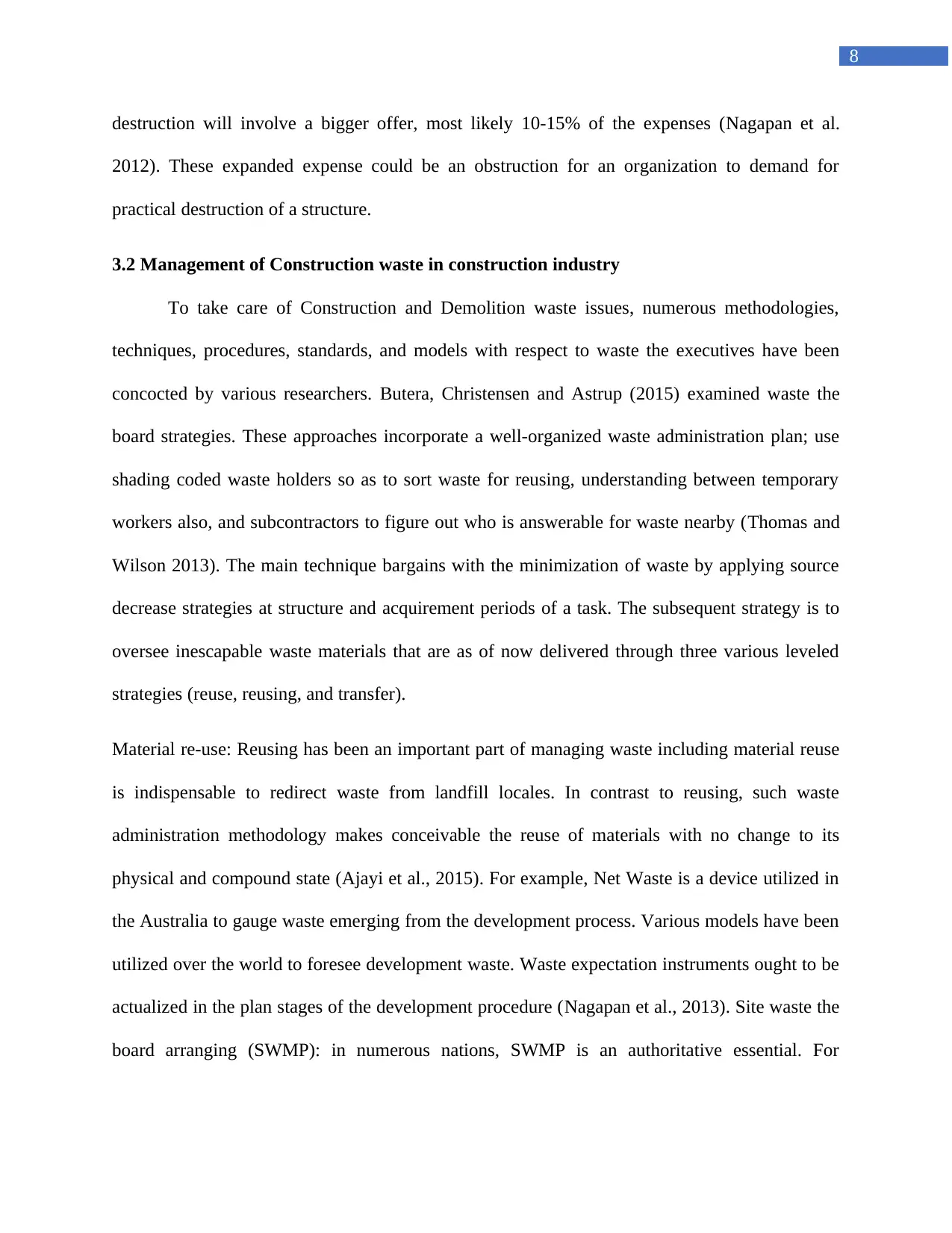
8
destruction will involve a bigger offer, most likely 10-15% of the expenses (Nagapan et al.
2012). These expanded expense could be an obstruction for an organization to demand for
practical destruction of a structure.
3.2 Management of Construction waste in construction industry
To take care of Construction and Demolition waste issues, numerous methodologies,
techniques, procedures, standards, and models with respect to waste the executives have been
concocted by various researchers. Butera, Christensen and Astrup (2015) examined waste the
board strategies. These approaches incorporate a well-organized waste administration plan; use
shading coded waste holders so as to sort waste for reusing, understanding between temporary
workers also, and subcontractors to figure out who is answerable for waste nearby (Thomas and
Wilson 2013). The main technique bargains with the minimization of waste by applying source
decrease strategies at structure and acquirement periods of a task. The subsequent strategy is to
oversee inescapable waste materials that are as of now delivered through three various leveled
strategies (reuse, reusing, and transfer).
Material re-use: Reusing has been an important part of managing waste including material reuse
is indispensable to redirect waste from landfill locales. In contrast to reusing, such waste
administration methodology makes conceivable the reuse of materials with no change to its
physical and compound state (Ajayi et al., 2015). For example, Net Waste is a device utilized in
the Australia to gauge waste emerging from the development process. Various models have been
utilized over the world to foresee development waste. Waste expectation instruments ought to be
actualized in the plan stages of the development procedure (Nagapan et al., 2013). Site waste the
board arranging (SWMP): in numerous nations, SWMP is an authoritative essential. For
destruction will involve a bigger offer, most likely 10-15% of the expenses (Nagapan et al.
2012). These expanded expense could be an obstruction for an organization to demand for
practical destruction of a structure.
3.2 Management of Construction waste in construction industry
To take care of Construction and Demolition waste issues, numerous methodologies,
techniques, procedures, standards, and models with respect to waste the executives have been
concocted by various researchers. Butera, Christensen and Astrup (2015) examined waste the
board strategies. These approaches incorporate a well-organized waste administration plan; use
shading coded waste holders so as to sort waste for reusing, understanding between temporary
workers also, and subcontractors to figure out who is answerable for waste nearby (Thomas and
Wilson 2013). The main technique bargains with the minimization of waste by applying source
decrease strategies at structure and acquirement periods of a task. The subsequent strategy is to
oversee inescapable waste materials that are as of now delivered through three various leveled
strategies (reuse, reusing, and transfer).
Material re-use: Reusing has been an important part of managing waste including material reuse
is indispensable to redirect waste from landfill locales. In contrast to reusing, such waste
administration methodology makes conceivable the reuse of materials with no change to its
physical and compound state (Ajayi et al., 2015). For example, Net Waste is a device utilized in
the Australia to gauge waste emerging from the development process. Various models have been
utilized over the world to foresee development waste. Waste expectation instruments ought to be
actualized in the plan stages of the development procedure (Nagapan et al., 2013). Site waste the
board arranging (SWMP): in numerous nations, SWMP is an authoritative essential. For
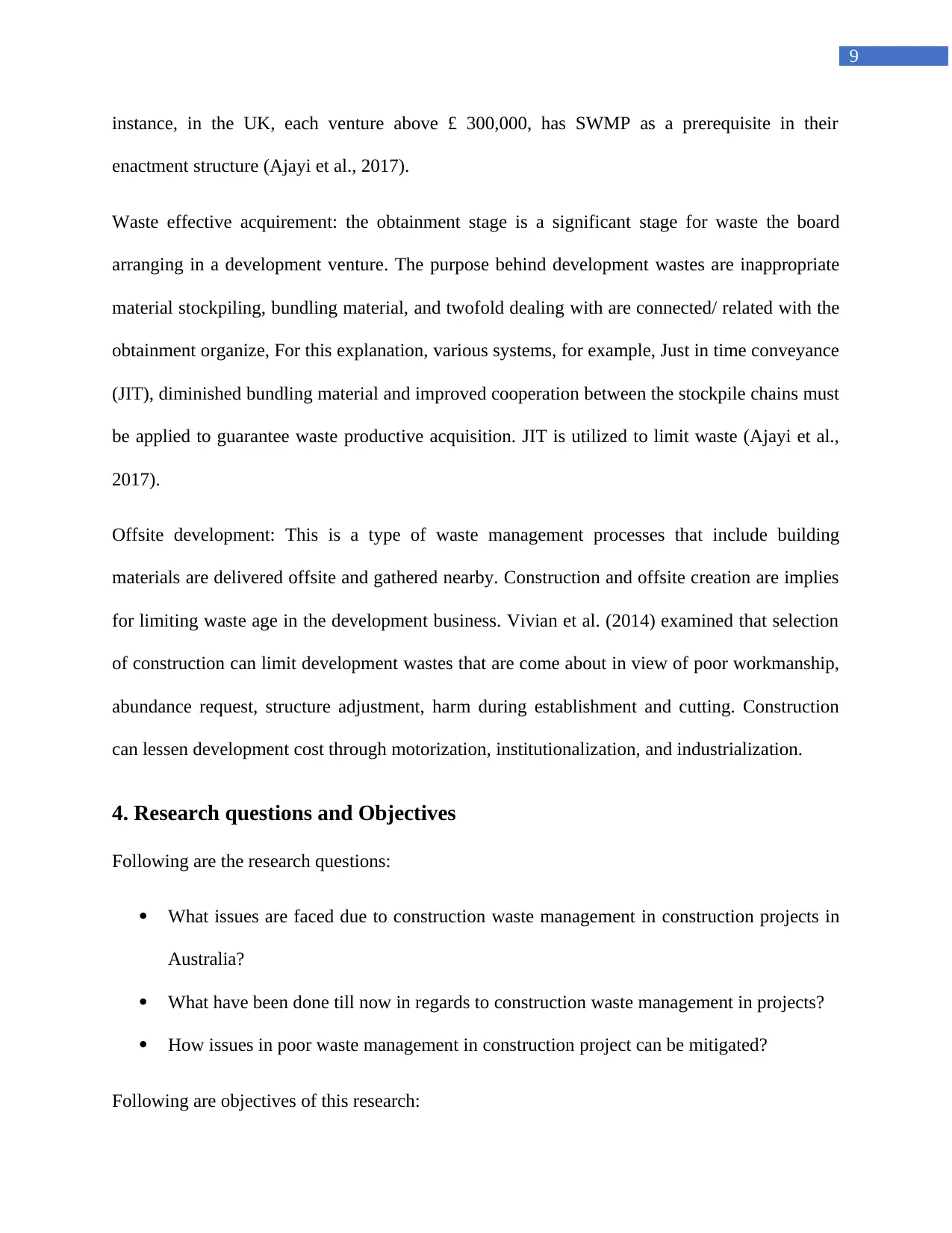
9
instance, in the UK, each venture above £ 300,000, has SWMP as a prerequisite in their
enactment structure (Ajayi et al., 2017).
Waste effective acquirement: the obtainment stage is a significant stage for waste the board
arranging in a development venture. The purpose behind development wastes are inappropriate
material stockpiling, bundling material, and twofold dealing with are connected/ related with the
obtainment organize, For this explanation, various systems, for example, Just in time conveyance
(JIT), diminished bundling material and improved cooperation between the stockpile chains must
be applied to guarantee waste productive acquisition. JIT is utilized to limit waste (Ajayi et al.,
2017).
Offsite development: This is a type of waste management processes that include building
materials are delivered offsite and gathered nearby. Construction and offsite creation are implies
for limiting waste age in the development business. Vivian et al. (2014) examined that selection
of construction can limit development wastes that are come about in view of poor workmanship,
abundance request, structure adjustment, harm during establishment and cutting. Construction
can lessen development cost through motorization, institutionalization, and industrialization.
4. Research questions and Objectives
Following are the research questions:
What issues are faced due to construction waste management in construction projects in
Australia?
What have been done till now in regards to construction waste management in projects?
How issues in poor waste management in construction project can be mitigated?
Following are objectives of this research:
instance, in the UK, each venture above £ 300,000, has SWMP as a prerequisite in their
enactment structure (Ajayi et al., 2017).
Waste effective acquirement: the obtainment stage is a significant stage for waste the board
arranging in a development venture. The purpose behind development wastes are inappropriate
material stockpiling, bundling material, and twofold dealing with are connected/ related with the
obtainment organize, For this explanation, various systems, for example, Just in time conveyance
(JIT), diminished bundling material and improved cooperation between the stockpile chains must
be applied to guarantee waste productive acquisition. JIT is utilized to limit waste (Ajayi et al.,
2017).
Offsite development: This is a type of waste management processes that include building
materials are delivered offsite and gathered nearby. Construction and offsite creation are implies
for limiting waste age in the development business. Vivian et al. (2014) examined that selection
of construction can limit development wastes that are come about in view of poor workmanship,
abundance request, structure adjustment, harm during establishment and cutting. Construction
can lessen development cost through motorization, institutionalization, and industrialization.
4. Research questions and Objectives
Following are the research questions:
What issues are faced due to construction waste management in construction projects in
Australia?
What have been done till now in regards to construction waste management in projects?
How issues in poor waste management in construction project can be mitigated?
Following are objectives of this research:
⊘ This is a preview!⊘
Do you want full access?
Subscribe today to unlock all pages.

Trusted by 1+ million students worldwide

10
To identify issues faced due to construction waste management in construction projects in
Australia
To acknowledge about progress in mitigating issues in waste management in construction
projects
To recommend strategies for resolving these issues in waste management in construction
projects
To provide training to employees for managing their resources efficiently
To adopt new technologies and recycling techniques of waste management in
construction industry
5. Research Methodology
5.1 Research Approach
Research philosophy is a concept related to the data collection and analysis. Data need to
be collected for analyzing it in the research. Research philosophy help[s in deciding the method
of data collection to be used in the study. There are two types of research philosophy which
include positivism and interprtivism. Positivism philosophy deals with the knowledge and skills
adopted in the research. Positivism helps in collecting data and information related to the study
in a scientific way. Interpretivism philosophy relates with social behavior of human beings in
the society. Therefore, positivism philosophy has been selected in the research. It helps in
collecting data within a scientific and statistical approach. The researcher has analyzed various
theories and models related to the research topic that have helped in analyzing basic information
about the topic. It is a highly structured as it help in collecting data and information for the study.
This research has elected a deductive approach in the study. This approach has helped in
analyzing data and information in a quantitative manner. The use of deductive approach has
To identify issues faced due to construction waste management in construction projects in
Australia
To acknowledge about progress in mitigating issues in waste management in construction
projects
To recommend strategies for resolving these issues in waste management in construction
projects
To provide training to employees for managing their resources efficiently
To adopt new technologies and recycling techniques of waste management in
construction industry
5. Research Methodology
5.1 Research Approach
Research philosophy is a concept related to the data collection and analysis. Data need to
be collected for analyzing it in the research. Research philosophy help[s in deciding the method
of data collection to be used in the study. There are two types of research philosophy which
include positivism and interprtivism. Positivism philosophy deals with the knowledge and skills
adopted in the research. Positivism helps in collecting data and information related to the study
in a scientific way. Interpretivism philosophy relates with social behavior of human beings in
the society. Therefore, positivism philosophy has been selected in the research. It helps in
collecting data within a scientific and statistical approach. The researcher has analyzed various
theories and models related to the research topic that have helped in analyzing basic information
about the topic. It is a highly structured as it help in collecting data and information for the study.
This research has elected a deductive approach in the study. This approach has helped in
analyzing data and information in a quantitative manner. The use of deductive approach has
Paraphrase This Document
Need a fresh take? Get an instant paraphrase of this document with our AI Paraphraser
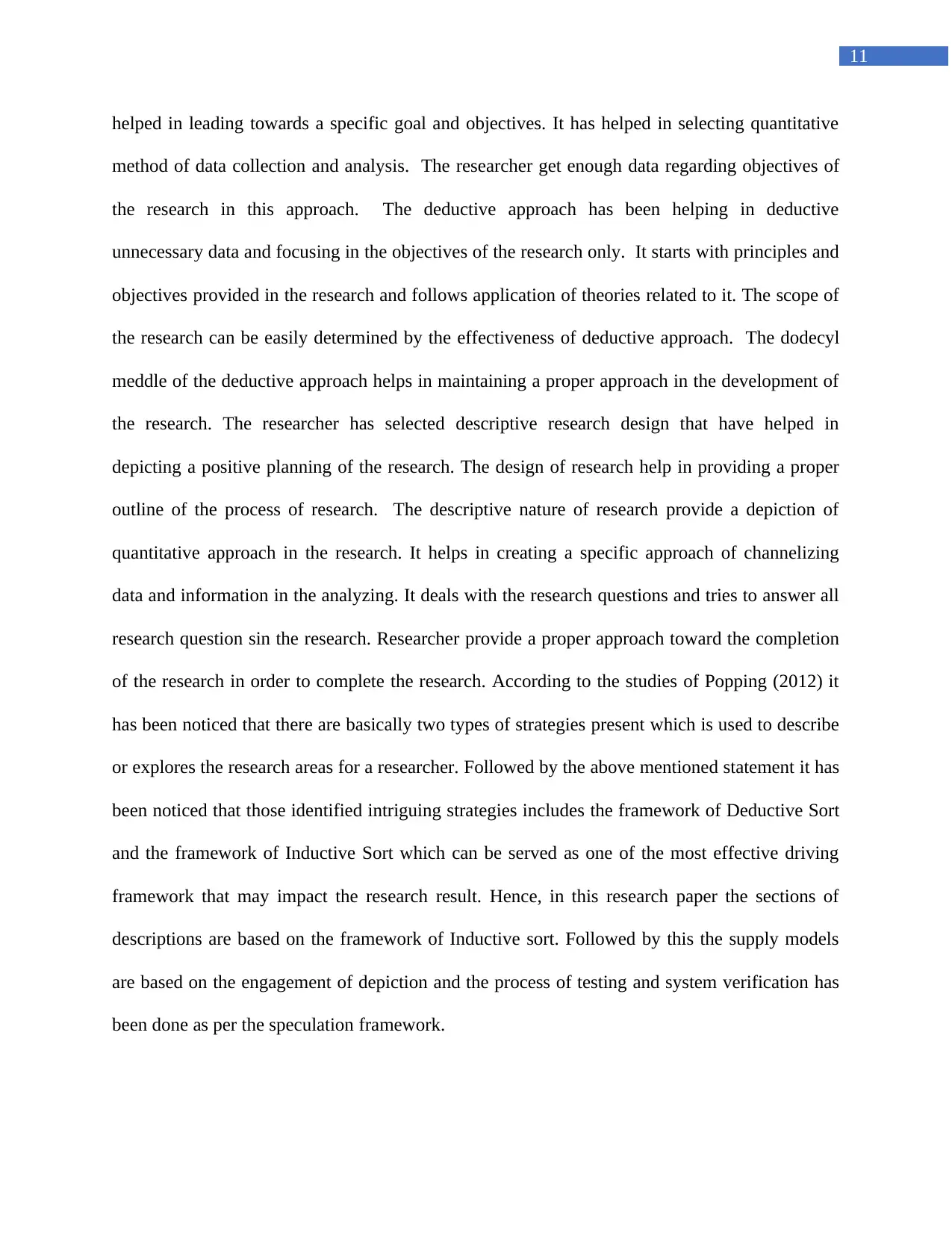
11
helped in leading towards a specific goal and objectives. It has helped in selecting quantitative
method of data collection and analysis. The researcher get enough data regarding objectives of
the research in this approach. The deductive approach has been helping in deductive
unnecessary data and focusing in the objectives of the research only. It starts with principles and
objectives provided in the research and follows application of theories related to it. The scope of
the research can be easily determined by the effectiveness of deductive approach. The dodecyl
meddle of the deductive approach helps in maintaining a proper approach in the development of
the research. The researcher has selected descriptive research design that have helped in
depicting a positive planning of the research. The design of research help in providing a proper
outline of the process of research. The descriptive nature of research provide a depiction of
quantitative approach in the research. It helps in creating a specific approach of channelizing
data and information in the analyzing. It deals with the research questions and tries to answer all
research question sin the research. Researcher provide a proper approach toward the completion
of the research in order to complete the research. According to the studies of Popping (2012) it
has been noticed that there are basically two types of strategies present which is used to describe
or explores the research areas for a researcher. Followed by the above mentioned statement it has
been noticed that those identified intriguing strategies includes the framework of Deductive Sort
and the framework of Inductive Sort which can be served as one of the most effective driving
framework that may impact the research result. Hence, in this research paper the sections of
descriptions are based on the framework of Inductive sort. Followed by this the supply models
are based on the engagement of depiction and the process of testing and system verification has
been done as per the speculation framework.
helped in leading towards a specific goal and objectives. It has helped in selecting quantitative
method of data collection and analysis. The researcher get enough data regarding objectives of
the research in this approach. The deductive approach has been helping in deductive
unnecessary data and focusing in the objectives of the research only. It starts with principles and
objectives provided in the research and follows application of theories related to it. The scope of
the research can be easily determined by the effectiveness of deductive approach. The dodecyl
meddle of the deductive approach helps in maintaining a proper approach in the development of
the research. The researcher has selected descriptive research design that have helped in
depicting a positive planning of the research. The design of research help in providing a proper
outline of the process of research. The descriptive nature of research provide a depiction of
quantitative approach in the research. It helps in creating a specific approach of channelizing
data and information in the analyzing. It deals with the research questions and tries to answer all
research question sin the research. Researcher provide a proper approach toward the completion
of the research in order to complete the research. According to the studies of Popping (2012) it
has been noticed that there are basically two types of strategies present which is used to describe
or explores the research areas for a researcher. Followed by the above mentioned statement it has
been noticed that those identified intriguing strategies includes the framework of Deductive Sort
and the framework of Inductive Sort which can be served as one of the most effective driving
framework that may impact the research result. Hence, in this research paper the sections of
descriptions are based on the framework of Inductive sort. Followed by this the supply models
are based on the engagement of depiction and the process of testing and system verification has
been done as per the speculation framework.
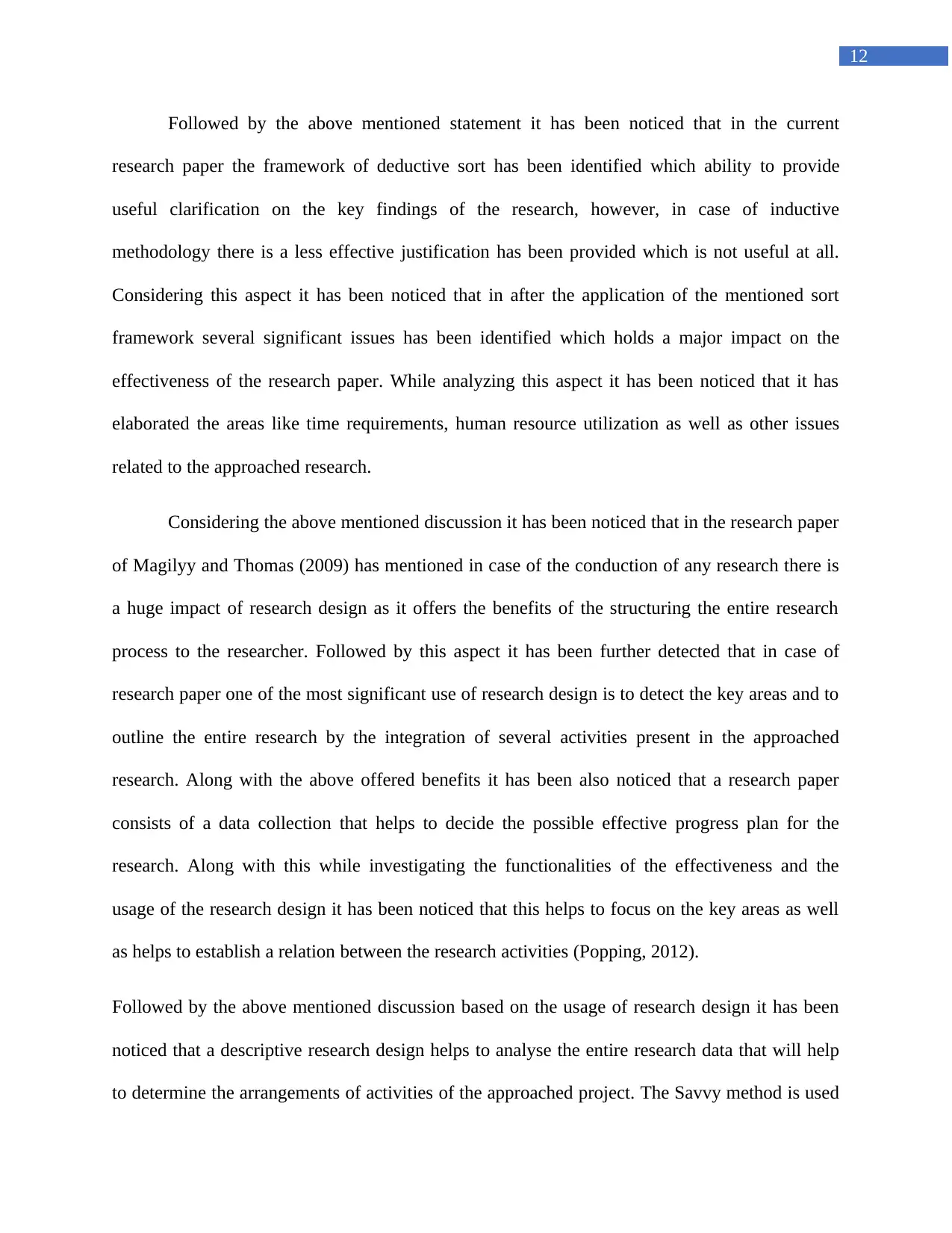
12
Followed by the above mentioned statement it has been noticed that in the current
research paper the framework of deductive sort has been identified which ability to provide
useful clarification on the key findings of the research, however, in case of inductive
methodology there is a less effective justification has been provided which is not useful at all.
Considering this aspect it has been noticed that in after the application of the mentioned sort
framework several significant issues has been identified which holds a major impact on the
effectiveness of the research paper. While analyzing this aspect it has been noticed that it has
elaborated the areas like time requirements, human resource utilization as well as other issues
related to the approached research.
Considering the above mentioned discussion it has been noticed that in the research paper
of Magilyy and Thomas (2009) has mentioned in case of the conduction of any research there is
a huge impact of research design as it offers the benefits of the structuring the entire research
process to the researcher. Followed by this aspect it has been further detected that in case of
research paper one of the most significant use of research design is to detect the key areas and to
outline the entire research by the integration of several activities present in the approached
research. Along with the above offered benefits it has been also noticed that a research paper
consists of a data collection that helps to decide the possible effective progress plan for the
research. Along with this while investigating the functionalities of the effectiveness and the
usage of the research design it has been noticed that this helps to focus on the key areas as well
as helps to establish a relation between the research activities (Popping, 2012).
Followed by the above mentioned discussion based on the usage of research design it has been
noticed that a descriptive research design helps to analyse the entire research data that will help
to determine the arrangements of activities of the approached project. The Savvy method is used
Followed by the above mentioned statement it has been noticed that in the current
research paper the framework of deductive sort has been identified which ability to provide
useful clarification on the key findings of the research, however, in case of inductive
methodology there is a less effective justification has been provided which is not useful at all.
Considering this aspect it has been noticed that in after the application of the mentioned sort
framework several significant issues has been identified which holds a major impact on the
effectiveness of the research paper. While analyzing this aspect it has been noticed that it has
elaborated the areas like time requirements, human resource utilization as well as other issues
related to the approached research.
Considering the above mentioned discussion it has been noticed that in the research paper
of Magilyy and Thomas (2009) has mentioned in case of the conduction of any research there is
a huge impact of research design as it offers the benefits of the structuring the entire research
process to the researcher. Followed by this aspect it has been further detected that in case of
research paper one of the most significant use of research design is to detect the key areas and to
outline the entire research by the integration of several activities present in the approached
research. Along with the above offered benefits it has been also noticed that a research paper
consists of a data collection that helps to decide the possible effective progress plan for the
research. Along with this while investigating the functionalities of the effectiveness and the
usage of the research design it has been noticed that this helps to focus on the key areas as well
as helps to establish a relation between the research activities (Popping, 2012).
Followed by the above mentioned discussion based on the usage of research design it has been
noticed that a descriptive research design helps to analyse the entire research data that will help
to determine the arrangements of activities of the approached project. The Savvy method is used
⊘ This is a preview!⊘
Do you want full access?
Subscribe today to unlock all pages.

Trusted by 1+ million students worldwide
1 out of 27
Related Documents
Your All-in-One AI-Powered Toolkit for Academic Success.
+13062052269
info@desklib.com
Available 24*7 on WhatsApp / Email
![[object Object]](/_next/static/media/star-bottom.7253800d.svg)
Unlock your academic potential
Copyright © 2020–2025 A2Z Services. All Rights Reserved. Developed and managed by ZUCOL.





